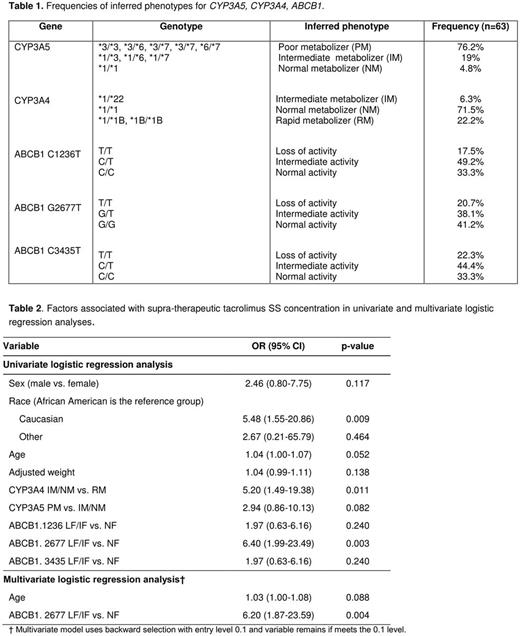Abstract
Background: Tacrolimus is the backbone of immunosuppressive therapy in patients undergoing an allogeneic stem cell transplant (SCT). Significant inter-patient variability in tacrolimus exposure exists, partly due to variations in pharmacokinetic genes. In particular, the Clinical Pharmacogenetics Implementation Consortium (CPIC) guidelines provide dosing recommendations based on CYP3A5 genotype; however, these are based on studies performed in patients undergoing solid organ transplants and receiving oral tacrolimus. We aimed to investigate the impact of CYP3A4, CYP3A5, and ABCB1 polymorphisms on intravenous (IV) tacrolimus exposure in allogeneic SCT patients.
Methods: Buccal swabs were collected from allogeneic SCT patients on the day of admission (prior to transplant) between 07/03/14 and 06/22/2017. DNA was extracted using the GenElute™ Mammalian Genomic DNA Kit. A custom Ion AmpliSeq™ PGx Panel was used to genotype the samples for polymorphisms in CYP3A5 (*3, *6, *7), CYP3A4 (*1B, *22) and ABCB1 (C1236T, G2677T, C3435T), and the corresponding phenotypes were inferred based on available guidelines and literature. IV tacrolimus infusion was started at 0.03 mg/kg on day +5 post-transplant. Blood samples were drawn every 2 days, and doses were adjusted after reaching steady-state (SS), targeting a plasma concentration of 5-15 ng/mL. The primary endpoint was the prevalence of non-therapeutic concentrations at SS (4th day after starting tacrolimus) between phenotypes, which was compared using the Fisher's exact test. Univariate and multivariable logistic regression analyses were performed to explore demographic variables and gene phenotypes associated with prevalence of non-therapeutic SS concentrations. Student's t-test was used to compare mean tacrolimus SS concentration between phenotypes.
Results: The study included 63 adult patients with a mean age of 54 (range 25-78) years. The majority were male (65%), 73% were Caucasian and 22% were African American. The inferred phenotype frequencies for CYP3A5, CYP3A4 and ABCB1 are shown in Table 1. No patient (0%) had an initial sub-therapeutic tacrolimus SS concentration (< 5 ng/mL), whereas 28.6% (n=18) and 71.4% (n=45) had an initial therapeutic and supra-therapeutic tacrolimus SS concentration (> 15 ng/mL), respectively. The prevalence of supra-therapeutic tacrolimus SS concentration was 80% in CYP3A4 NM/IMs and 43% among CYP3A4 RMs (p=0.016). Approximately 87% of carriers of at least one copy of the loss of function allele for ABCB1 C2677T (2677 CT and 2677 TT) had a supra-therapeutic tacrolimus SS concentration compared to 50% in non-carriers (2677 CC, p=0.004). Alternatively, there were no significant differences in the prevalence of supra-therapeutic SS concentrations by CYP3A5, ABCB1 C1236T, and ABCB1 C3435T genotypes (p>0.05). Univariate logistic regression analysis identified Caucasian race (p=0.009), CYP3A4 (p=0.011), and ABCB1 C2677T (p=0.003) as significantly associated with supra-therapeutic SS concentrations (Table 2). Of these, only ABCB1 C2677T was retained in the multivariable model (p=0.004). The mean tacrolimus SS concentration in CYP3A4 IM/NMs and RMs were 16.9 ± 4.5 ng/mL and 14.2 ± 3.9 ng/mL, respectively (p=0.048). Carriers of the T allele for ABCB1 C2677T (2677 CT and 2677 TT) had a significantly higher mean tacrolimus SS concentration compared to non-carriers (17.5 ± 4.3 ng/mL vs. 14.6 ± 4.2 ng/mL, p=0.009). There was no significant difference in the mean tacrolimus SS concentration based on CYP3A5, ABCB1 C1236T and ABCB1 C3435T polymorphisms (p>0.05).
Conclusion: ABCB1 C2677T and CYP3A4 appear to be important determinants of tacrolimus exposure after IV administration in adult patients receiving an allogeneic SCT. Our results did not demonstrate an association between CYP3A5 genotype and tacrolimus concentration, possibly due to IV administration and differential expression of CYP3A5 (higher in the gut resulting in first-pass metabolism). Further studies are necessary to validate these findings on a larger scale and to evaluate genotype-guided dose selection to optimize tacrolimus exposure. Future guidelines should discuss potential differences in pharmacogenetics findings between oral and IV tacrolimus and different populations (SCT vs. solid organ transplant).
Trivedi: Pharmacyclics: Consultancy, Honoraria. Grunwald: Alexion: Consultancy; Incyte: Consultancy, Research Funding; Celgene: Consultancy; ARIAD: Consultancy; Cardinal Health: Consultancy; Amgen: Consultancy, Research Funding; Pfizer: Consultancy; Forma Therapeutics: Research Funding; Janssen: Research Funding; Genentech: Research Funding. Ghosh: Seattle Genetics: Consultancy, Honoraria, Research Funding; Bristol Myers Squibb: Consultancy, Honoraria, Research Funding; Jassen: Consultancy, Honoraria, Research Funding; Kite Pharma: Consultancy, Honoraria; Celgene: Consultancy, Honoraria, Research Funding, Speakers Bureau; TG Therapeutics: Consultancy, Honoraria, Research Funding; Gilead: Consultancy, Honoraria, Speakers Bureau; AbbVie: Consultancy, Honoraria, Speakers Bureau; Pharmacyclics: Consultancy, Honoraria, Research Funding, Speakers Bureau.
Author notes
Asterisk with author names denotes non-ASH members.


This feature is available to Subscribers Only
Sign In or Create an Account Close Modal